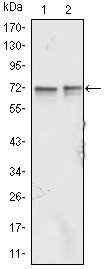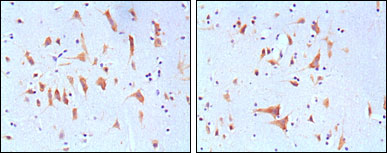- 首页
- 公司介绍
- 热门促销
-
全部产品
-
试剂盒
- |
-
一抗
- |
-
二抗
- |
-
蛋白
- |
-
免疫组化试剂
- |
-
WB 试剂
- PonceauS Staining Solution
- PBST Washing Buffer, 10X
- 1.5M Tris-HCl Buffer, pH8.8
- 1M Tris-HCl Buffer, pH6.8
- 10% SDS Solution
- Prestained Protein Marker
- TBST Washing Buffer, 10X
- SDS PAGE Loading Buffer, 5X
- Stripping Buffered Solution
- Tris Buffer, pH7.4, 10X
- Total Protein Extraction Kit
- Running Buffer, 10X
- Transfer Buffer, 10X
- 30% Acr-Bis(29:1) Solution
- Tris电泳液速溶颗粒
- PBS(1X, premixed powder)
- TBS(1X, premixed powder)
- 快速封闭液
- 转膜液速溶颗粒
- Chemical reagents
- 公司新闻
- 营销网络
- 资源中心
- 联系我们
FMR1 Monoclonal Antibody
- 货号:YM0280
- 应用:WB;IHC;IF;ELISA
- 种属:Human
- 蛋白名称:
- Fragile X mental retardation 1 protein
- 免疫原:
- Purified recombinant fragment of human FMR1 expressed in E. Coli.
- 特异性:
- FMR1 Monoclonal Antibody detects endogenous levels of FMR1 protein.
- 组成:
- Liquid in PBS containing 50% glycerol, 0.5% BSA and 0.02% sodium azide.
- 稀释:
- WB 1:500 - 1:2000. IHC 1:200 - 1:1000. IF 1:200 - 1:1000. ELISA: 1:10000. Not yet tested in other applications.
- 纯化工艺:
- Affinity purification
- 储存:
- -15°C to -25°C/1 year(Do not lower than -25°C)
- 其他名称:
- FMR1;Fragile X mental retardation protein 1;FMRP;Protein FMR-1
- 背景:
- The protein encoded by this gene binds RNA and is associated with polysomes. The encoded protein may be involved in mRNA trafficking from the nucleus to the cytoplasm. A trinucleotide repeat (CGG) in the 5' UTR is normally found at 6-53 copies, but an expansion to 55-230 repeats is the cause of fragile X syndrome. Expansion of the trinucleotide repeat may also cause one form of premature ovarian failure (POF1). Multiple alternatively spliced transcript variants that encode different protein isoforms and which are located in different cellular locations have been described for this gene. [provided by RefSeq, May 2010],
- 功能:
- alternative products:At least 12 different isoforms are produced,disease:Defects in FMR1 are the cause of fragile X syndrome. [MIM:300624]. It is a common genetic disease (has a prevalence of one in every 2000 children) which is characterized by moderate to severe mental retardation, macroorchidism (enlargement of the testicles), large ears, prominent jaw, and high-pitched, jocular speech. The defect in most fragile X syndrome patients results from an amplification of a CGG repeat region which is directly in front of the coding region.,disease:Defects in FMR1 are the cause of fragile X tremor/ataxia syndrome (FXTAS) [MIM:300623]. In FXTAS, the expanded repeats range in size from 55 to 200 repeats and are referred to as 'premutations'. Full repeat expansions with greater than 200 repeats results in fragile X mental retardation syndrome [MIM:300624]. Carriers of the premutation typically d
- 细胞定位:
- Nucleus . Nucleus, nucleolus . Chromosome, centromere . Chromosome . Cytoplasm . Cytoplasm, perinuclear region . Cytoplasm, Cytoplasmic ribonucleoprotein granule . Perikaryon . Cell projection, neuron projection . Cell projection, axon . Cell projection, dendrite . Cell projection, dendritic spine . Cell junction, synapse, synaptosome . Cell projection, growth cone . Cell projection, filopodium tip . Cell junction, synapse . Cell junction, synapse, postsynaptic cell membrane . Cell junction, synapse, presynaptic cell membrane . Cell membrane . Cytoplasm, Stress granule . Colocalizes with H2AX/H2A.x in pericentromeric heterochromatin in response to DNA damaging agents (By similarity). Localizes on meiotic pachytene-stage chromosomes (By similarity). Forms nuclear foci representing sites of
- 组织表达:
- Expressed in the brain, cerebellum and testis (PubMed:8401578). Also expressed in epithelial tissues (PubMed:8401578). Expressed in mature oligodendrocytes (OLGs) (PubMed:23891804). Expressed in fibroblast (PubMed:24204304). Expressed in neurons, Purkinje cells and spermatogonias (at protein level) (PubMed:8401578). Expressed in brain, testis and placenta (PubMed:8504300). Expressed in neurons and lymphocytes (PubMed:8504300).

- Western Blot analysis using FMR1 Monoclonal Antibody against Jurkat (1) and K562 (2) cell lysate.

- Immunohistochemistry analysis of paraffin-embedded human brain tissues, showing cytoplasmic localization with DAB staining using FMR1 Monoclonal Antibody.

- Immunofluorescence analysis of NIH/3T3 cells using FMR1 Monoclonal Antibody (green). Blue: DRAQ5 fluorescent DNA dye. Red: Actin filaments have been labeled with Alexa Fluor-555 phalloidin.






